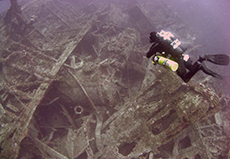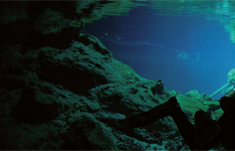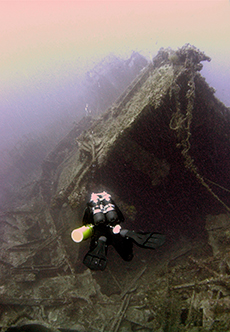




| Home | Features | Club Nights | Underwater Pics | Feedback | Non-Celebrity Diver | Events | 8 August 2025 |
| Blog | Archive | Medical FAQs | Competitions | Travel Offers | The Crew | Contact Us | MDC | LDC |

|

|
 
 |
 |
ISSUE 10 ARCHIVE - AN ARMCHAIR DIVER'S GUIDE TO TECH KITPaulo Vincenzo ToomerYou are as excited as Adam waiting for the miracle of his missing rib being turned into some prime totty in the Garden of Eden. You have just returned from a little spending spree down your local dive emporium. The boot of your car is overflowing with kit. Twinset, regs, a neat little gauge, a wing, a roll of webbing, a packet of D rings, a VRx... You name it, it's in that boot. |
 |
 |
So, you have carted it all into the
lounge, relocated the family to a
nearby motel for the lack of room and
you are now ready to get building. Ha
Ha! Whatever! Bring it on fat boy! Do
you remember when you were a kid
and your Dad was building that 5,000
piece jigsaw of the sky at night? Six
months and all he had was the corners.
So how the hell do you put all this crap together and why is it setup that way? First stop, Internet. Crikey, there is the GUE/DIR/TDI/IANTD/DSAT/BSAC etc way of doing it. Long hose here, short hose there, BCD inflator left, dry suit right. Sheesh, it could drive you to drink. |
|
 |
With that in mind I would like to approach
this very controversial topic with an open
mind and discuss some of the options
you have for rigging your tech kit and
more importantly why. I am not for one
minute saying that my way is right, all I
have done with my personal rig is make
it so it is set up in a fashion that will
allow me to safely and comfortably
execute the extreme diving I do.
So let's find a nice can, hopefully full of worms and set about opening it. Let's start with the twinset. I like steel twins, and I really like those long Euro-cylinders (they push your bum down!) but to be honest, standard length ones will do the job spot on. When it comes to valves, try and get yourself some old MDE ones, they are awesome but for some reason MDE decided to stop production. In light of this, I am using any manifold I can get my paws on, but I service the valves regularly so they spin easily when practising shut downs. I prefer wide steel bands rather than the thin ones, as they stop any twisting of the twinset. The final components to my twinset are my wonderful 'V' weights. I LOVE 'V' weights. They are V-shaped weights that fit neatly between the cylinders. No more weight belts, evil little b******s that they are. I use a tail weight, which is a "V" weight that hangs from the lower band of the twin, thus offsetting the weight of the valves which gives me perfect trim in the water. |
|
|
To get the twin to stick to your back
you could use a roll of gaffer tape but
a wing and harness would probably
be nicer, more gentle on the skin.
So another conundrum – steel or
aluminium plate? I like steel, as it
means I wear less weight especially in a
drysuit, but an aluminium plate is great
for travelling. To get the plate to hang
on your back you will need a harness.
Do you get a harness with or without a
break in it? And should I get one or two
breaks? I dive a single strand harness,
but it also has a break. All my break
does is extend the harness to facilitate
an easy removal, especially in the
event of me ever needing rescue (God
forbid). I do think that two breaks are
excessive, as you only need to remove
one arm from your harness to get out
of it. I do not like clutter either, so all I
have in terms of 'D' Rings etc on my rig
are 2 shoulder 'D' Rings, two waist Billy
Rings (Rigid D Rings) and a waist
buckle. Really simple. You will also need
a crotch strap and I recommend the
2" version as the thin ones kind of split
you down the middle, which is a little
uncomfortable. But more importantly,
the 2" strap has a butt 'D' Ring to
which you can attach your spools.
Attaching them here causes minimum
drag in the water.
Next up logically is the wing. All that matters is that it's black, or maybe red or grey? Actually, what you really need is sufficient lift in the wing to lift all the equipment you are wearing safely to the surface. I would start with a 50 pound capacity wing minimum. Double bladder or single bladder? If I was diving deep in a multi-cylinder setup while wearing a wetsuit I would most certainly be wearing a double bladder rig. You must have redundancy. While wearing a drysuit a single bladder wing is acceptable as the drysuit is the backup buoyancy. Bungeed or not bungeed? Ooh, now you are clawing at that can of worms. If you are planning on cave or wreck diving, then the bungee becomes an issue. I wear an internally bungeed wing and it never gets in the way no matter what environment I am working in. If you are planning on open water diving only, then the world is your lobster and you can pretty much choose what you like, I mean, what are you going to get the bungee tangled to? The other issue with bungee is streamlining. Externally bungeed wings are not as streamlined, so try internal bungee or none at all even. When it comes to regulators, the most important thing is that you get a really good high performance set. A Scubapro MK2 R190 may be a fine shallow water reg but it will not be happy at 60 metres. However, club/ school level regulators make awesome deco regs, as they are usually bullet proof. So how do we setup our backgas regulators? The lid on the can of worms previously mentioned has just been blown into orbit. Let's get to it! The most important rule, and I don't believe you will get many arguments about this, is the long hose (2 metres) must go on the right hand pillar valve, as you wear it. The long hose is usually the hose you breathe from and this hose is also used to share gas with an out of air teammate. It allows the out of air diver to dive in front of the donor (single file) so the donor can fully control the situation. Should the cylinder impact the roof in an overhead environment, the RHS pillar valve will roll on, whereas the LHS will roll off. If the reg in your mouth stops delivering gas you just reach behind and turn it on. Your teammate does not have the same options, especially in a limited movement area. The long hose should have a single piston clip tied to it, so it can be pinned away especially when the diver starts using deco gas. |
 | |
|
Then we have the short hose. This
should be attached to the left hand
valve. It should have a neck bungee
and is only used should you have
an emergency of some description.
Most tech divers use only one SPG and this is attached to the LHS. It has a piston clip tied to it to keep it streamlined. Simple, two gauges is total overkill. The biggest bone of contention is where do the BCD/Drysuit inflators run? If you decide to feed the BCD inflator from the right hand side (RHS) you will have made all the equipment on the RHS "Primary" and all LHS equipment 'Backup'. This sounds really grand and when wearing a drysuit (fed from LHS in this case), should you have a catastrophic gas loss, which will usually be from the RHS as that's the one you are breathing, you just shutdown, switch regs and then use the drysuit for buoyancy. What about if you are wearing a wetsuit? Now you will have to shutdown, switch, find your backup inflator, attach the BCD hose (this is never attached in case it accidently goes off behind your back) and then re-establish neutral buoyancy. Bear in mind that this could happen on descent. You might be wearing two stages. There will probably be no air in your wing. You will also have to equalise. And... you are on an 800-metre wall. Sound like fun? Hell no. The dive has just opened a can of whoop ass on you my boy. So I wear my rig slightly differently. I have my drysuit or backup inflator coming from the RHS and my wing from the left, if I have a gas problem, I simply shutdown and switch. Because my inflator is on the LHS it does not get turned off. Perfect. The most wonderful thing about having my rig set up this way is that I can manage the valves from the front of the rig and never have to worry whether the valves are on. All I use are my observation skills. No reaching behind all the time to check. If I can't breathe, then the RHS post is off. If my gauge does not move from the original fill pressure, then my manifold is switched off as the gauge is on the LHS post. Finally, if my gauge moves violently or my BCD will not inflate, I know immediately that my LHS post is turned off. This simple setup allows me total peace of mind and it cannot be achieved by crossing the inflator hoses. As per usual, opinions may vary with mine so please do keep an open mind to change. For example, perhaps Adam may have given a third testicle to create Eve and not a rib. Next time round we look at putting the accessories like surface marker buoys, spools, reels, computers, cutting devices etc, onto the rig. You can email Auntie Toomer with any of your dive queries and you might also like to check out The Diving Matrix. |
 | |
Previous article « The Sea Doc Investigates: Reefs and their Ambassadors Next article » Sharkipedia Back to Issue 10 Index | ||